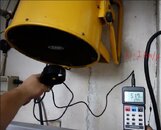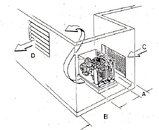Swamp diver,
I wasn't looking at their most expensive hardware. I am looking at their portable air compressors to use with a Nitrox Stick

That Bauer B-Trox system looks like it would need one big suitcase full of Euro bills.
Burhan you're quite right that a suitcase of Euro is likely neeed. Not sure exactly but probably in the 18,000 range for one of the smaller ones.
I would agree that given your circumstances whereby you cannot ensure that the tanks coming to you have been properly O2 cleaned the nitrox stick is probably the way to go. Most of the severe injuries and fatalities (there was one in Florida about 5 years ago) which have happened involved tanks during the fill process which had unverifiable O2 cleaning. Just because someone purchases a sticker on the Internet saying their tank is O2 clean does not mean it is clean,...huge problem over here.
Also as you point out a tank that was initially O2 clean can become unclean when it is taken to another fill station where the air quality is suspect. We switched to a membrane system partly to reduce the risk of this problem once it became very evident by inspecting tank valve seats quarterly that a lot of oil and particulate was coming from other fill stations which claimed to be pumping oxygen compatible air.
In terms of compressor choices I am partial to Bauer but realize they are more expensive than the Coltri. I'm not sure what type of liability you have to worry about over there in Libya, but Coltri will provide documentation that their compressors can be used to pump up to 40% nitrox at 3600 psig should you require this. Bauer Europe will not unless you purchase a 12.14-OX block or larger.
I'll tell you a bit of a secret though which is Bauer USA is pairing its stock air compressors with a membrane system developed by Brownie's using a membrane and Kaeser lp compressor. There are no modifications such as stage temp monitoring nor an extra 1st/2nd stage separator like you find on the Euro Bauer nitrox compressors.
Brownie's Patented Nitrox Maker(TM) to be Featured at Bauer Compressors, Inc.'s Booth at the DEMA Dive Industry Trade Show OTCBB:BWMG
As you know from reading on here lots of people have been using air compressors to pump nitrox without incident although there are several steps you can take to mitigate the risk such as:
1. use only a high quality synthetic oil as these have a higher autoignition point and fewer flammable volatiles sitting above the oil compared with a mineral oil.
2. probably most important is to keep the compressor as cool as possible. Put a large axial blast fan on the stage heads and only pump at night when it is coolest. All the compressors are under-ventilated when in hot tropical environments and require additional cooling. Plus you'll lower your maintenance costs by doing so.
3. make sure that you only use Viton 90 o-rings for the discharge valves or any other high heat, high pressure locations.
4. consider putting the high air temp alarm on the 4th stage if you are going to have a PLC control.
Have a look at this article just to refresh your knowledge regarding the potential risks and realize that the dive industry is the only group out there advocating the 40% rule.
If you do happen to find that wheelbarrow of money you might rather purchase a new Rix oil-less compressor.






